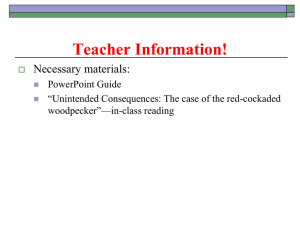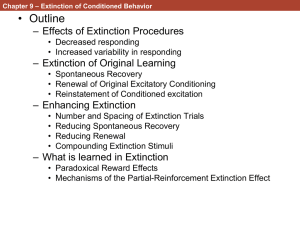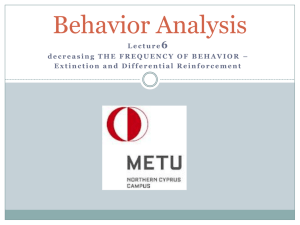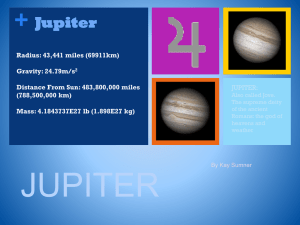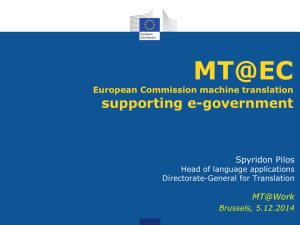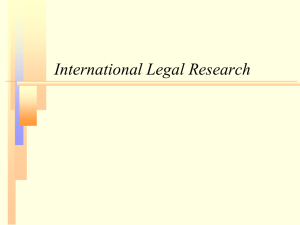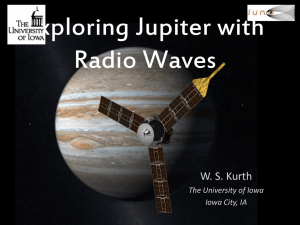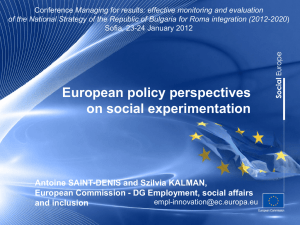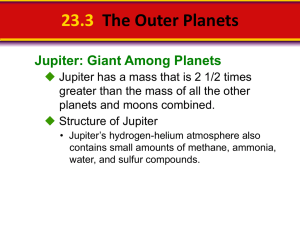Io and Europa Atmosphere and Io Torus Detection through
advertisement
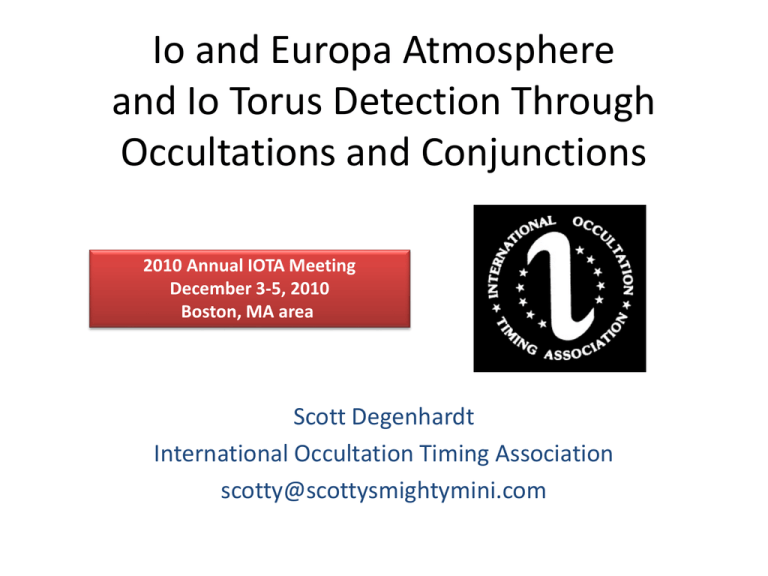
Io and Europa Atmosphere and Io Torus Detection Through Occultations and Conjunctions 2010 Annual IOTA Meeting December 3-5, 2010 Boston, MA area Scott Degenhardt International Occultation Timing Association scotty@scottysmightymini.com Having purchased this after attending the 2009 Society for Astronomical Sciences Conference, I hatched some hair brained ideas…. Scotty’s logic: If….. 1 lightcurve data point = a picture into a distant place and 1 picture = 1000 words then 1000 data point lightcurve X 1000 words = 1,000,000 words!!! 1 miniDV tape ~ 1 hour of video data So… Therefore!!! Double Jupiter Mutual Event of Aug 7, 2009 Io’s shadow eclipses Europa 23 minutes later Io occults Europa Io Europa • An anomalous trend was detected in the 20090807 IoII. • Theories were proposed for possible sources of this anomaly. • Possible sources fell into 4 main categories: 1. Camera response 2. Recording method 3. Reduction method 4. Extinction via Io’s atmosphere • Experiments were designed to validate or refute each. • Using a model derived from the 20090807 lightcurve predictions of atmospheric extinction were created for the upcoming 20090901 IoII, which did repeat the anomaly as predicted based on that atmospheric model. Europa’s motion brightening Io dimming Europa 3.6” = 6 Io radii IAEP (Io Atmospheric Extinction Project) was launched, a global plea for observations was made. IAEP RESULTS WERE PUBLISHED AND PRESENTED: Degenhardt, S. et. al (2010), Io and Europa Atmosphere Detection through Jovian Mutual Events, The Society for Astronomical Sciences: Proceedings for the 29th Annual Symposium on Telescope Science, p. 91-100 http://scottysmightymini.com/IAEP/SAS2010_Io_Europa_Degenhardt.doc YouTube video in four parts of the SAS 2010 Power Point Presentation: Part 1: http://www.youtube.com/watch?v=LJE_V9Jysto Part 2: http://www.youtube.com/watch?v=0BFRpbTc748 Part 3: http://www.youtube.com/watch?v=02s4KIZ55NE Part 4: http://www.youtube.com/watch?v=UECOxlFKLVI IAEP results: 11 observers 4 countries 53 data sets 28 individual events Typical lightcurve for extended wing data: Io and Europa have dimmed intensity trends surrounding the occultation. (We dubbed this “lowered shoulders”) Ganymede wing data displayed a brightening intensity trend surrounding the occultation. (We dubbed “raised shoulders”) Simulation indicates “raised shoulders” to be the nominal response to two merging intensities of near equal brightness. raised shoulder = nonlinear camera response creating the non-flat wings. preliminary investigation: source = region between the two airy disks As the photons in the outer rings of the airy disks begin to overlap, previously undetected photon rates become detectable due to the doubling of the photon rate. Photon Doubling Effect (PDE) PDE region (intensity above baseline between merging spots) baseline intensity False color intensity profile of Io (left peak) and Europa (right peak) A “light bridge” is clearly seen forming between the two merging spots Preliminary wing trend conclusion PDE causes a nonlinear intensity increase as two airy disks of near equal intensity merge resulting in raised shoulders. Raised shoulders should be the nominal response for two merging intensities of near equal brightness. Therefore lowered shoulders indicate an anomalous loss of intensity in the measurement aperture. Now we need to identify the source of the loss of light… This data analysis technique of the raw video intensity effectively single handedly eliminates nonlinear camera response, recording method, and reduction technique as the source of lowered shoulders. Europa (behind Io) experiences dimming as it nears Io. Two photometry methods used: Individual photometry: A measurement aperture is placed on each moon individually. Individual intensities are normalized to a common moon. Combined photometry: One large aperture surrounds both target moons. Total intensity of the large measurement aperture is normalized to a common moon. Possible sources fell into 4 main categories: 1. Camera response 2. Recording method 3. Reduction method 4. Extinction via Io’s atmosphere Dimming source conclusion: o The source of the dimming has been linked to the moon being occulted by Io or Europa. o The start of dimming and end of brightening defines boundaries of extinctive material. o Moons being occulted by Io suffer extinction of their light when they are within 5 to 30 Io radii of Io. o Moons being occulted by Europa suffer extinction within 22 to 30 Europa radii of Europa. o Moons being occulted by Ganymede do not suffer extinction at these same distances. o An asymmetry was noticed in the slope trend of the ingress/egress of extinction in both Io and Europa lightcurves. If Io was west of Jupiter and occulted a moon with its western limb: Ingress/egress > 1 If Io was east of Jupiter and occulted a moon with its western limb: Ingress/egress < 1 Conclusions on asymmetry of Io atmospheric extinction: Occultations on Io’s Jupiter facing limb have longer extinction slopes. Longer extinction indicates more extinction material. More extinction material on Io’s Jupiter facing limb possibly implies a stream of material from Io towards Jupiter. This comes as no surprise given that Jupiter is called the “vacuum cleaner” of our solar system. Why? Why have these extinction events been missed for 400 years…? Likely due to insufficient wing data surrounding Jupiter Mutual Events. Lightcurve (b.) is the same event as (a.), only (a.) has just 6 minutes of wing data surrounding the occultation (typical of what is found in the NSDC IMCCE database). How small can your system be?! •20100104 UT marked the end of the JME cycle •This was not the end of Jovian Extinction Events •Occultation misses, i.e. conjunctions still provide opportunities for extinction measurements •Conjunctions remove the camera response issues associated with merging spots. Io’s eastern and western Torus tips appear more dense due to an optical geometry where the Torus material is collimated to our line of sight. Schematic of a Torus Jovian Extinction Event (TJEE) Torus material Io 160 Io radii Collimated Torus material at the tip of Torus Torus of Io (viewed from above) Earth’s view Data provided by Wayne Green Io Spectra taken by John Menke HOW CAN I PARTICIPATE? I see the following potential research that can be done now: 1. Detection of extinction through video recordings in modest equipment. Begin making plans now to observe the next round of Jupiter Mutual Event occultations in 2014. 2. PDE experiments to better our understanding of our observed nonlinear intensity gain with merging spots. 3. Detection of Io or Europa atmosphere through transits by any astrophotographer that carefully does his work. 4. Data mining of IMCCE NSDC lightcurves, Hubble, Voyager, Galileo, and Don Parker images (just kidding Don!), all sorts of things to look for now that we have pointed it out to everyone in the paper. 5. Jovian Extinction Event observations. Io Torus detection and modeling, and Io and Europa atmosphere modeling through conjunctions. 6. Spectroscopy of Torus extinction events. 7. Think outside the box (or rather your box should have elastic walls and not cement)! You do not have to wait 4 years (2014) for the next Jupiter Mutual Event Cycle to measure extinction! Jovian Extinction Event predictions for 2010 are available here: http://scottysmightymini.com/JEE/JEE.htm scotty@scottysmightymini.com Salvador Aguirre Sonora, Mexico Dave Clark Texas, USA Scott Degenhardt Tennessee, USA Tony George Oregon, USA Donald Parker Florida, USA Terry Redding Florida, USA Andy Scheck Maryland, USA Brad Timerson New York, USA Not pictured but submitting data sets: Wayne Green – Colorado, USA Mike Hoskinson – Alberta, Canada John Menke – Maryland, USA Roger Venable – Georgia, USA FINAL CONCLUSION • Dimming trends of Io and Europa occultations have been linked to atmospheric extinction of the light of the moon being occulted. • Asymmetries of the slope of extinction have been noted. • No extinction trend has been detected for Ganymede. • Extinction events caused by the Torus of Io and conjunctions with Io and Europa are detectable, further validating the extinction hypothesis. • A 3D model of these atmospheres should be possible by inverting the lightcurves derived by our observational method. • Extinction detection is possible in modest equipment. Further photometric and spectroscopic data collection is a must to gain better statistical data on the material causing the extinction phenomenon. • Detection of extinctive material around our Jupiter may have implications for other Jupiter like exoplanet research.

